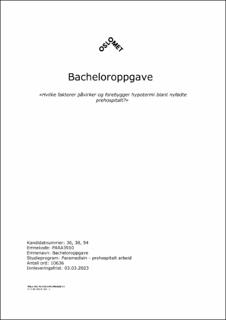Hvilke faktorer påvirker og forebygger hypotermi blant nyfødte prehospitalt?
Abstract
Bakgrunn: Hypotermi er et globalt problem som kan oppstå ved alle fødsler. Nyfødte har økt risiko for hypotermi grunnet redusert evne til temperaturregulering og varmeproduksjon. Prehospital varmekonservering er utfordrende, og nedleggelse av fødetilbud har økt antall prehospitale fødsler i Norge. Vi ønsker å øke fokus på neonatal hypotermi og temperaturregulerende tiltak i ambulansen ved å undersøke hvilke faktorer som påvirker og forebygger hypotermi blant nyfødte prehospitalt. Metode: Vi har anvendt litteraturstudie som metode. For å belyse problemstillingen har vi hentet inn litteratur fra fagbøker, nettsider og systematiske søk i Medline, Cinahl og Cochrane Library. Totalt har vi inkludert seks kvantitative artikler i bacheloroppgaven. Resultat: Forskning identifiserte at lav fødselsvekt, respiratorisk støtte, prematuritet, lav omgivelsestemperatur, manglende monitorering av temperatur og lav initial kroppstemperatur økte risikoen for neonatal hypotermi. For å forebygge hypotermi blant nyfødte vil hensiktsmessige varmekonserverende tiltak være plastikkpose, termisk teppe, varmebag, kuvøse og standardiserte tiltak som tørking, innpakking, tildekking av hodet, amming og "hud mot hud". Konklusjon: Ved å sammenlikne litteraturen i bacheloroppgaven har vi identifisert at kombinasjoner av flere varmekonserverende metoder gir høyest neonatal kroppstemperatur. Videre vil kunnskap om faktorer som påvirker neonatal hypotermi øke fokus på varmekonserverende tiltak og forebygge hypotermi blant nyfødte prehospitalt. Fremtidig forskning og oppdaterte prosedyrer er nødvendig for å optimalisere neonatal varmekonservering i ambulansen. Objective:
Hypothermia is a global problem that can occur in all childbirths.Newborns are at increased risk of hypothermia because of reduced ability to regulate temperature. Prehospital heat preservation is challenging, and closure of maternity wards has increased prehospital births in Norway. We
wish to increase paramedics focus on neonatal hypothermia and heat-preventing measures in the ambulance, by investigating what factors that affect and prevent hypothermia among newborns.
Methods:
The chosen method in this bachelor thesis is a literature study. We have collected literature from academic books, websites and systematic searches in Medline, Cinahl and Cochrane Library to answer our researche
question. We have included six quantitative articles in total.
Results:
Research identified that low birth weight, respiratory support, prematurity, low ambient temperature, lack of temperature monitoring and low initial body temperature increased the risk of neonatal hypothermia. To prevent hypothermia among newborns, appropriate heat-preserving measures will be plastic bag, thermal blanket, portable thermal nest, incubator and standardized measures such as drying, covering, cap, breastfeeding and “skin to skin”.
Conclusion:
We have identified that combinations of several heat-preserving measures give the highest neonatal body temperature. Increased knowledge about factors affecting hypothermia among infants will increase paramedics focus on heat-preventing measures and prevent neonatal hypothermia. Furture research and updated protocols are needed to optimize neonatal heat preservation in the ambulance.

